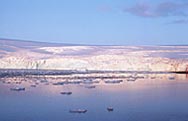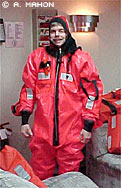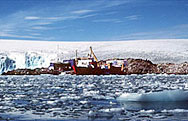It is Saturday afternoon and we are finally underway to Palmer (for real this time, we hope). The technician who flew down from Louisiana, where the contractor that runs the ship is based, arrived late yesterday afternoon and had the original problem fixed in a few hours.
We started out in the early evening. Unfortunately, a different but related electronics problem cropped up when the ship went to full power, so the technician was brought back on board. He had us all ready to go again by 2 a.m., but by then, our original Chilean pilot had been called back to port. We waited until 10:30 a.m. for another pilot to become available.
Why do we need a pilot? Like so many things that we deal with, the reason is for safety. The pilot knows the local waters and will guide us safely eastward through the Straits of Magellan and out into the South Atlantic Ocean. Safety is a big issue everywhere, but there are, as you likely imagine, some special considerations at sea.
The first thing we had to consider was just where and how we stowed our gear. The tables, closets, etc., where we have our things will soon be rocking and rolling (hopefully not too badly) and we have to have everything secure to be sure it does not fall or slide into something else and break. We must also make sure that nothing fragile is below something that could fall onto it in rough seas. It would be sad to lose a camera, computer, or piece of scientific equipment now.
More important than the safety of our belongings is the safety of ourselves. Right before we were originally scheduled to leave on Thursday all the passengers were called together for a safety briefing. Each of us has been issued a life preserver and survival suit, and we were instructed to bring those with us to the briefing so that the crew could be sure that they fit us and that we knew how to put them on.
The life preservers look nice, but what is really important are the survival suits. These are very similar to the dry suits we will be using for diving in Antarctica but they are designed to also act like a life preserver. The waters we are headed to around the Peninsula will range from about 30 to 34 degrees Fahrenheit (salt water freezes at about 28 F). Without the thermal protection one has in a survival suit (or a dry suit), the cold water will kill a person in a few minutes. So these are very important suits!
We all took off our shoes and climbed into our survival suits. The lounge we were in was small to hold all of us to begin with, and so it was quite a commotion with all of us wriggling into these huge plastic bags, but we all got in. The suits have built in shoes and a heavy-duty waterproof zipper up the front that is just like the ones in our dry suits. They fasten securely around the neck and have a thick hood with a flap that covers your face to keep it warm. The wrist seals are very similar to our dry suits, and there are thick wetsuit mittens attached to the arms. I hope I never have to get into one for real but am confident that I could do so quickly.
After we got into and out of our suits we went up on the top deck to get into the life boats (if it was "for real" we would have kept the suits on). Although the ship is equipped with covered rafts, too, the main life boats are more like little floating submarines. They are, essentially, water tight tubes with rounded ends that can roll 360 degrees and still not sink. We climbed into the tube and strapped ourselves in using harnesses similar to those you would expect to see in a fighter jet. The ship has two of these lifeboats, each of which alone is big enough to carry everyone on board. They have a motor and a small window so that they can be piloted away and to safety.
It is great to know that we have all this advanced safety equipment. I look forward to getting back into all of it -- but not until our next safety briefing when we are on the ship and heading south to Palmer Station again in November 2001.




